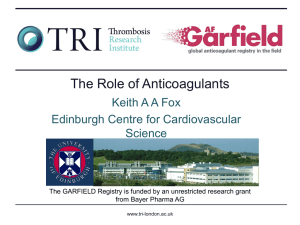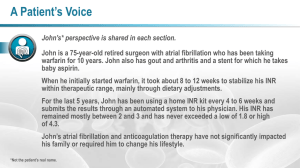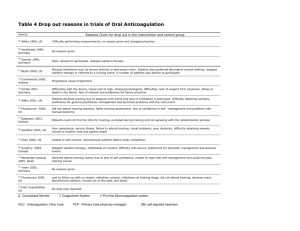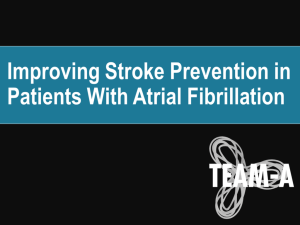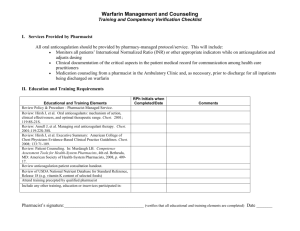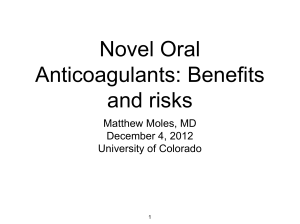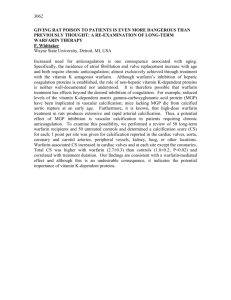L M I
advertisement
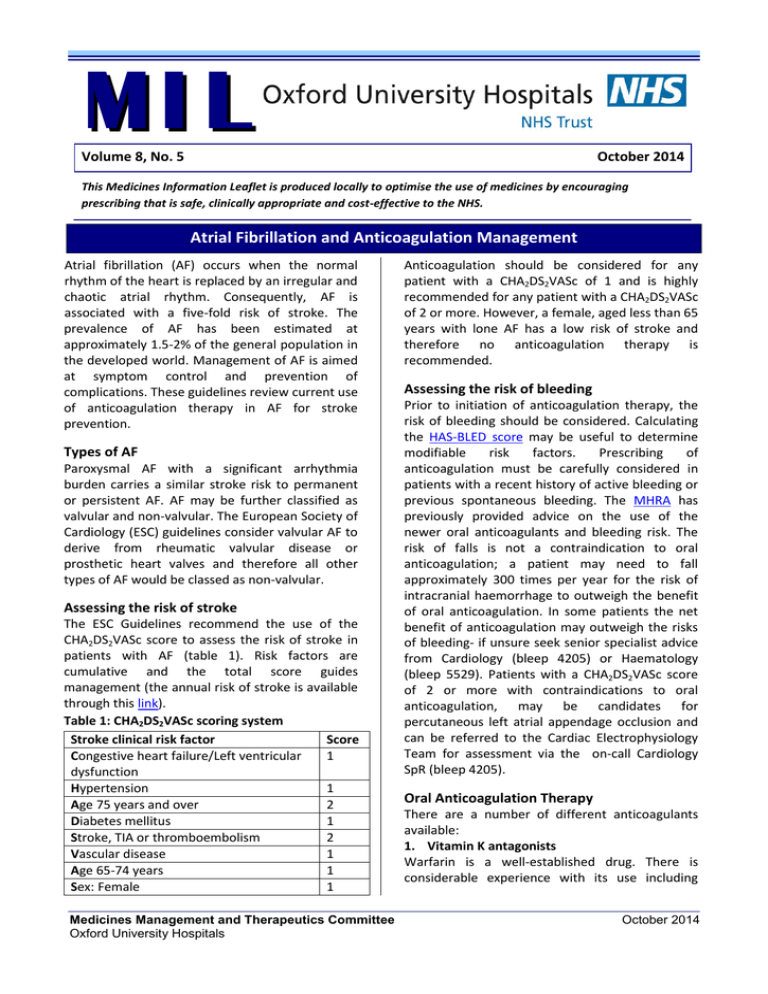
MI L Volume 8, No. 5 October 2014 This Medicines Information Leaflet is produced locally to optimise the use of medicines by encouraging prescribing that is safe, clinically appropriate and cost-effective to the NHS. Atrial Fibrillation and Anticoagulation Management Atrial fibrillation (AF) occurs when the normal rhythm of the heart is replaced by an irregular and chaotic atrial rhythm. Consequently, AF is associated with a five-fold risk of stroke. The prevalence of AF has been estimated at approximately 1.5-2% of the general population in the developed world. Management of AF is aimed at symptom control and prevention of complications. These guidelines review current use of anticoagulation therapy in AF for stroke prevention. Types of AF Paroxysmal AF with a significant arrhythmia burden carries a similar stroke risk to permanent or persistent AF. AF may be further classified as valvular and non-valvular. The European Society of Cardiology (ESC) guidelines consider valvular AF to derive from rheumatic valvular disease or prosthetic heart valves and therefore all other types of AF would be classed as non-valvular. Assessing the risk of stroke The ESC Guidelines recommend the use of the CHA2DS2VASc score to assess the risk of stroke in patients with AF (table 1). Risk factors are cumulative and the total score guides management (the annual risk of stroke is available through this link). Table 1: CHA2DS2VASc scoring system Stroke clinical risk factor Score Congestive heart failure/Left ventricular 1 dysfunction Hypertension 1 Age 75 years and over 2 Diabetes mellitus 1 Stroke, TIA or thromboembolism 2 Vascular disease 1 Age 65-74 years 1 Sex: Female 1 Medicines Management and Therapeutics Committee Oxford University Hospitals Anticoagulation should be considered for any patient with a CHA2DS2VASc of 1 and is highly recommended for any patient with a CHA2DS2VASc of 2 or more. However, a female, aged less than 65 years with lone AF has a low risk of stroke and therefore no anticoagulation therapy is recommended. Assessing the risk of bleeding Prior to initiation of anticoagulation therapy, the risk of bleeding should be considered. Calculating the HAS-BLED score may be useful to determine modifiable risk factors. Prescribing of anticoagulation must be carefully considered in patients with a recent history of active bleeding or previous spontaneous bleeding. The MHRA has previously provided advice on the use of the newer oral anticoagulants and bleeding risk. The risk of falls is not a contraindication to oral anticoagulation; a patient may need to fall approximately 300 times per year for the risk of intracranial haemorrhage to outweigh the benefit of oral anticoagulation. In some patients the net benefit of anticoagulation may outweigh the risks of bleeding- if unsure seek senior specialist advice from Cardiology (bleep 4205) or Haematology (bleep 5529). Patients with a CHA2DS2VASc score of 2 or more with contraindications to oral anticoagulation, may be candidates for percutaneous left atrial appendage occlusion and can be referred to the Cardiac Electrophysiology Team for assessment via the on-call Cardiology SpR (bleep 4205). Oral Anticoagulation Therapy There are a number of different anticoagulants available: 1. Vitamin K antagonists Warfarin is a well-established drug. There is considerable experience with its use including October 2014 2 significant long term safety data and reversal agents are readily available. Before initiating treatment, consideration should be given to both medical and social patient factors. Please refer to MIL volume 5, number 8 ‘Initiating oral anticoagulation with vitamin K antagonists in adult patients’ for detailed information. Prior to starting a patient on warfarin, a baseline coagulation screen (prothrombin time (PT)/INR and activated partial thromboplastin time (APTT)) must be performed. A suggested slow induction regime of 3mg daily, with an INR check between days 4 and 7 is advised. Concomitant LMWH cover is not required (thromboprophylaxis may be appropriate as per Trust VTE guidance). The recommended INR target is 2.5 (range 2.0 to 3.0). 2. New oral anticoagulants (NOACs) There are currently three NOACs licensed for use in non-valvular AF: dabigatran (a direct thrombin inhibitor), rivaroxaban and apixaban (direct factor Xa inhibitors). NICE has approved each drug for use in stroke prevention within their current licence. Specific patient criteria, as detailed in appendix 1, must be met. Concomitant heparin is not required. Prior to starting treatment with a NOAC, a baseline coagulation screen, full blood count, U&Es (including renal function) and liver function must be performed. No monitoring of the therapeutic effects of NOACs is required. Dabigatran and rivaroxaban should be taken with food. There are currently no antidotes to reverse the effects of NOACs. Local advice on the management of haemorrhage and overdose are available via the Anticoagulation and Thrombosis website. Choice of anticoagulant therapy Warfarin may be preferred by some patients on the basis that there are decades of experience and an antidote. It is preferred in patients with liver dysfunction or significant renal impairment. It can also be an advantage to have a monitored treatment in the poorly compliant. The newer agents are potentially more convenient. Compared with warfarin all have a reduced risk of intracranial haemorrhage. Dabigatran 150 mg bd and apixaban 5 mg bd have a reduced risk of stroke and systemic embolization and dabigatran 150 mg bd has a reduced risk of ischaemic stroke. Dabigatran 110 mg bd and apixaban 5 mg bd have a reduced risk of major Medicines Information Leaflet bleeding and clinically relevant non-major bleeding. Dabigatran would not be the optimum choice in those with a creatinine clearance less than 50 ml/min nor in those with ischaemic heart disease or dyspepsia. Table 2 summarises these options. Table 2: Guidance on choice of anticoagulant Anticoagulant Comments Warfarin Preferred in liver dysfunction, in significant renal impairment and in the poorly compliant Apixaban Compared to warfarin reduced risk of stroke and reduced major and clinically relevant bleeding Rivaroxaban Similar efficacy and safety to warfarin. Once a day dosing. Dabigatran Compared to warfarin reduced risk of stroke with 150 mg bd; reduced major and minor bleeding with 110 mg bd. 150 mg bd only drug demonstrated to reduce ischaemic stroke compared to warfarin. Not first choice if creatinine clearance less than 50 ml/min, in ischaemic heart disease or for patients with dyspepsia. If a patient is suitable for all 3 NOACs, apixaban would be the recommended first line option. Renal impairment The NOACs are renally excreted to variable extents and therefore should be used with caution in renal impairment (appendix 1). Apixaban is the least renally cleared NOAC. Warfarin is the preferred option in patients with a creatinine clearance below 30ml/min because of a lack of outcome data for NOACs in this setting. Pregnancy and Breastfeeding Oral anticoagulation therapy is contraindicated in pregnancy and therefore pregnancy should be excluded prior to starting treatment. Warfarin is a known teratogen and women of child-bearing potential should be counselled appropriately. Warfarin is excreted into breast milk in small amounts but is considered safe for use. NOACs should not be used in breastfeeding. 3 Medicines Information Leaflet Medication Compliance Atrial flutter Patients with poor compliance need careful assessment. INR monitoring enables assessment of compliance with warfarin and therefore is the preferred option in such patients. Given no monitoring is required for NOACs, assessment and reinforcement of compliance do not take place. These guidelines are applicable to the management of patients diagnosed solely with atrial flutter. It is recognised that there is no data for using NOACs in this setting, but they be an appropriate choice for some patients. Drug interactions Warfarin is well-known to interact with a large range of drugs and foods and therefore concurrent use of any other medicine should be carefully checked. All three NOACs are substrates for the Pglycoprotein transporter. Additionally, both rivaroxaban and apixaban are metabolised via the cytochrome P4503A4 system. Appendix 1 details many of the currently known interactions. Notably, concurrent use of antiplatelets and nonsteroidal anti-inflammatories significantly increases the patient’s risk of bleeding and combined use requires very careful consideration of the risks and benefits. The following provides some guidance on antiplatelets and anticoagulants: o o Stable coronary artery disease patients (more than 12 months away from ACS, NSTEMI, STEMI, CABG or stent): If warfarin, rivaroxaban or apixaban is started, antiplatelet therapy can be stopped, unless high risk of future coronary events (prior stenting of the left main, proximal left anterior descending, proximal bifurcation, recurrent MIs), in which case Cardiology advice should be sought. Until more data are available we would caution against the use of dabigatran in this setting. Anyone who develops an ACS or undergoes coronary intervention whilst on an oral anticoagulant for AF, or is diagnosed with AF within 12 months of a coronary event or procedure, should have their antiplatelet and anticoagulant regimen discussed with the relevant interventional cardiologist. Duration of therapy Long term treatment with either warfarin or a NOAC is required. Cardioversion and ablation Separate guidelines on the short term use of NOACs in patients undergoing ablation and cardioversion are available (discuss with the Cardiac Electrophysiology team). Patient or carer education It is vital that all patients newly started on anticoagulation therapy receive written and verbal information. Any patient initiated on warfarin should be given the yellow warfarin booklet. Patient booklets containing alert cards are available from pharmacy for each NOAC. Patients should be encouraged to carry the alert cards with them at all times. Discharge arrangements Any warfarin patient must be referred to the Oxford Anticoagulation clinic (bleep 1857) for follow up at discharge. This includes both new and existing patients. Additionally, please inform the Oxford Anticoagulation clinic if you are switching one of their patients from warfarin to a NOAC. For patients who are not covered by the Oxford Anticoagulation Service, a referral must be made to the patients’ GP or local Anticoagulation Service. For further information, please refer to MIL volume 5, number 8. References 1. European Society of Cardiology. 2012 focused update of the ESC Guidelines for the management of atrial fibrillation. Euro Heart J 2012 33; 2719-45 2. NICE (2014). Atrial fibrillation: the management of atrial fibrillation. Accessed via http://www.nice.org.uk/guidance/cg180/resources /guidance-atrial-fibrillation-the-management-ofatrial-fibrillation-pdf [19/06/14] 3. MHRA Drug Safety Update 2013, 7(3). Accessed via www.mhra.gov.uk/home/groups/dsu/documents/ publication/con322740.pdf [18/11/13] 4. European Society of Cardiology. Guidelines for the management of atrial fibrillation Euro Heart J 2012 31; 2369-2429 5. Keeling D et al. Guidelines on oral anticoagulation with warfarin- fourth edition. Br J Haematol 2011 154; 311-324 6. Keeling D (2013). Oxford haemophilia and thrombosis centre protocols for out-patients anticoagulation with vitamin K antagonists. Accessed via http://ouh.oxnet.nhs.uk/anticoagulation/Pages/De fault.aspx [16/10/13] 4 7. 8. 9. Medicines Information Leaflet Heidbuchel H et al. European Heart Rhythm Association Practical Guide on the use of new oral anticoagulation in patients with non-valvular atrial fibrillation. Europace 2013 15; 625-51 UK Teratology Information Service. Use of warfarin in pregnancy 2012. Access via www.uktis.org/index.html [07/01/14] Summary of product characteristics for dabigatran, rivaroxaban and apixaban. Accessed via www.medicines.org.uk Prepared by: Vicki Price, Lead Anticoagulation Pharmacist With advice from: Dr D Keeling, Haematology Consultant, Dr T Betts, Cardiology Consultant, Joanne Coleman, Lead Cardiac Pharmacist and Dr C Forfar, Cardiology Consultant. Review date: October 2015 Appendix 1: NOAC drug comparison table for use in AF Criteria for use in non-valvular AF Standard Dose Reduced Dose Renal impairment Drug interactions** Pharmaceutical issues Switching from warfarin Switching to warfarin Dabigatran Presence of one or more of the following risk factors: -Previous stroke, transient ischemic attack or systemic embolism -Left ventricular ejection fraction less than 40 % -Symptomatic heart failure (NYHA Class 2 or above) -Age 75 years or older -Age 65-74 years with one of the following: diabetes mellitus, coronary artery disease or hypertension 150mg bd (with food) Rivaroxaban Presence of one or more of the following risk factors: -Congestive heart failure -Hypertension -Age 75 years or older -Diabetes mellitus -Prior stroke or transient ischaemic attack Apixaban Presence of one or more of the following risk factors: -Prior stroke or transient ischaemic attack -Age 75 years or older -Hypertension -Diabetes mellitus -Symptomatic heart failure (NYHA Class 2 or above) 20mg od (with food) 5mg bd 110mg bd age 80 years or older or concomitant use of verapamil. 15mg od where CrCl 15-49ml/min* 2.5mg bd if 2 or more of the following present: age 80 years or older, body weight 60 kg or less or serum creatinine 133 micromole/L or greater Consider dose reduction from 150mg bd to 110mg bd in the following: age 75-80 years, moderate renal impairment (CrCl 30-50ml/min*), patients with gastritis, oesophagitis or gastroesophageal reflux and other patients at increased risk of bleeding Do not use if CrCl less than 30ml/min* Consider dose reduction if CrCl 30-50ml/min* Avoid with HIV protease inhibitors, rifampicin, carbamazepine, phenytoin, phenobarbital, St John’s Wort, dronedarone, ciclosporin, tacrolimus, ketoconazole, itraconazole, voriconazole and posaconazole. Caution with amiodarone, verapamil, erythromycin and clarithromycin. Capsules can only be stored in original packaging and are not suitable for dosette boxes Stop warfarin and start dabigatran once INR less than 2 Start warfarin 2 days (CrCl 30-49ml/min) or 3 days (CrCl 50ml/min or above) before stopping dabigatran OR 2.5mg bd where CrCl 15-29ml/min* Do not use if CrCl less than 15ml/min* Use with caution if CrCl 15-29ml/min* Avoid with HIV protease inhibitors, ketoconazole, itraconazole, voriconazole, posaconazole and dronedarone. Caution with rifampicin, carbamazepine, phenytoin, phenobarbital, St John’s Wort, erythromycin and clarithromycin. Do not use if CrCl <15ml/min* May be dispersed in water Stable in dosette boxes Stop warfarin and start rivaroxaban once INR 3 or less Co-administer rivaroxaban and warfarin until INR 2 or greater Stable in dosette boxes Avoid with HIV protease inhibitors, ketoconazole, itraconazole, voriconazole and posaconazole. Caution with rifampicin, carbamazepine, phenytoin, phenobarbital, St John’s Wort, erythromycin and clarithromycin. Stop warfarin and start apixaban once INR is less than 2 Co-administer apixaban and warfarin for 2 days. After 2 days, check INR prior to next apixaban dose and continue until INR 2 or greater * NB: Warfarin is the preferred option in those with a creatinine clearance below 30ml/min. **This list is not exhaustive and only gives some common examples. Please check the data sheet (www.medicines.org.uk) or contact Pharmacy for advice at the point of prescribing. Medicines Management and Therapeutics Committee Oxford University Hospitals October 2014
